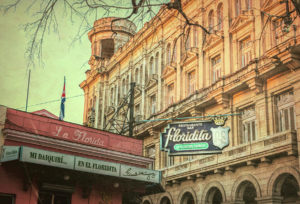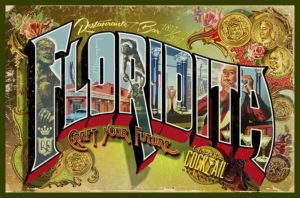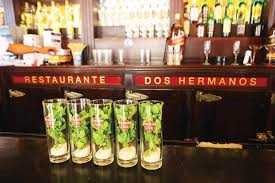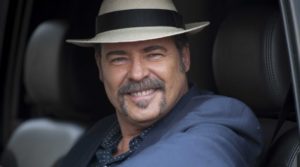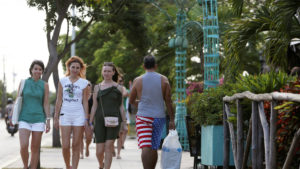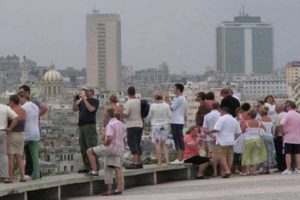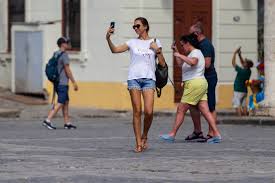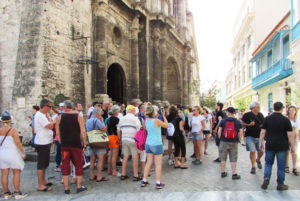 BARES Y COCTELES FAMOSOS DE MI SIEMPRE Y BELLA HABANA.
BARES Y COCTELES FAMOSOS DE MI SIEMPRE Y BELLA HABANA.
Quien no habra oido hablar de alguno de nuestros eternos y jamas olvidados Tragos y Bares famosos de mi bella ciudad capital. Unos que estuvieron vigente en época famosa y otros que han sido renovado para ser iman para los turistas que nos visitan de todas partes del mundo.
Desde el Bar ‘Vista al Golfo’ comencemos con el coctel Nacional y el Sloppy Joe con su “Cuba Libre” (que dejo su nombre abandonado hace ya mas de 60 años en nuestra querida republica-AV); en la Habana esta tambien la siempre recordada ‘Bodeguita del Medio’ y el ‘Floridita’ con el Mojito y el Daiquirí, que es de imaginar. El no menos conocido y visitado “Dos Hermanos” ofreciendo el trago conocido como el “Havana Special”. .. es una sorpresa todavia constatar la vigencia de ese trago que algunos llaman el ‘Manhattan cubano’, y que suponiamos olvidado ya en la preferencia y el paladar de los bebedores, aunque se reitera en la carta-menú de muchos bares no estatales actualmente.
Una mezcla cuya invención se atribuye a Constantino Ribalaigua, barman catalán radicado en la capital cubana, que se inspiró en una línea de transporte de pasajeros y mercancías que hacía el recorrido Nueva York-Cayo Hueso-La Habana-Nueva York.
Desde la Gran Manzana (NY), el tren demoraba dos días en llegar a Cayo Hueso, donde un servicio de ferry-boats, en una travesía de diez horas, transportaba los vagones hasta La Habana. Esa ruta se conoció con el nombre de The Havana Special y posibilitó que Cuba la aprovechara para reafirmarse como importante suministrador del mercado norteamericano. Cruzar el mar sentado cómodamente en un vagón de ferrocarril que antes avanzó sobre la cumbre angosta de una montaña de coral, parece cosa de hadas.
El bar ‘Dos Hermanos’ se ubica frente al muelle de The Havana Special y abrió sus puertas en 1892, lo que lo hace uno de los bares más antiguos de la capital cubana. Se caracterizó por su larga barra de madera dura, incompleta desde que le cercenaron un pedazo a fin de emplazarlo en uno de los bares del hotel Moka, en Las Terrazas.
Aún así, sigue siendo larga. El poeta español Federico García Lorca frecuentó el Dos Hermanos durante su estancia cubana de 1930, y por allí estuvieron asimismo, entre otros, Alejo Carpentier y Enrique Serpa, autor de novelas como Contrabando y La trampa, y de un cuento antológico, Aletas de tiburón.
Y, por supuesto, el inevitable Hemingway, que en la festinada opinión de algunos deambuló por todos los bares y cantinas habaneros, aunque centró su preferencia en el Floridita. En Dos Hermanos, «con pasos torpes que lo conducían a una pequeña pero satisfactoria libertad», entró una tarde Andrés, el protagonista de ‘Fiebre de caballos’ (1988), la novela inicial de Leonardo Padura. Al comienzo bebió lentamente su trago amargo y se dedicó a estudiar a la gente hasta que la cuarta o quinta cerveza lo dejó sin movimientos y empezó a ver neblinosos y deformes a los que lo rodeaban, como si estuviera viendo una película filmada con un grotesco ángulo ancho.
Floridita fue hasta 1959 el bar más famoso de la ciudad, pero Sloppy Joe’s fue siempre el de más ventas. Supuse que el Sloppy Joe’s de Cayo Hueso antecedió a este de la esquina de Zulueta y Ánimas, en La Habana.
Error. El Sloppy habanero se anticipó en 16 años al de Cayo Hueso, que se inauguró en 1934 y tres años después se instalaba en la calle Duval, ubicación que todavía mantiene, mientras que otro bar llamado ‘Capitán Tony’ ocupaba el espacio que el Sloppy original dejaba libre.
‘Capitán Tony’ no tiene la animación del Sloppy ni su hechizo, pero allí se da una situación insólita: muchas de las mujeres que lo visitan se despojan del ajustador y lo cuelgan en las tendederas que cruzan el salón.
Si Padura fijó el bar Dos Hermanos en la literatura, y Hemingway el Floridita en Islas en el golfo, el inglés Graham Greene, aficionado al ron añejo e inventor de cocteles diabólicos, inmortalizó el Sloppy Joe —y también al hotel Sevilla— en su novela ‘Nuestro hombre en La Habana’, llevada además al cine.
Un detalle interesante aporta una guía de 1954 publicada en Estados Unidos que facilitaba a turistas norteamericanos su visita a la Isla: Sloppy Joe’s era frecuentado por visitantes estadounidenses, no por los norteamericanos residentes. La colonia norteamericana en La Habana prefería el bar ‘Mis amigos’, en 7ma. y 42, Miramar, La Habana.
Floridita tuvo fluctuaciones con relación a sus parroquianos. La mayoría de ellos era de origen norteamericano hasta el inicio de la II Guerra Mundial. Durante la conflagración bélica se llenó de cubanos. Los norteamericanos no podían venir a causa de la guerra y los cubanos no podían salir.
Finalizada la guerra, nacionales y visitantes disfrutaron juntos su Daiquirí, que figura en la lista de diez grandes cocteles del mundo.
En 1937, el corresponsal en La Habana de la agencia norteamericana AP dedica una crónica a Constantino Ribalaigua. Refiere que un grupo de amigos conversaba sobre béisbol en uno de los bares del Hotel Nacional cuando uno de ellos preguntó sobre quién podría considerarse el mejor cantinero cubano. Constantino Ribalaigua, respondió el barman que los atendía, aunque la pregunta no le estaba dirigida expresamente. De inmediato, refiere el periodista, uno de los del grupo telefoneó al ‘Sloppy Joe’ y a ‘Prado 86’ y también a los bares de los hoteles Plaza y Sevilla, muy famosos en la época.
Obtuvo la misma respuesta. El reportero visitó a Constantino en Floridita y quedó maravillado. Confesó el barman que sus mejores cocteles eran Daiquirí, Presidente y Pepín Rivero, inspirado en el director-propietario del Diario de la Marina.
El escribidor, que tiene en su archivo las fórmulas de más de 300 cocteles recogidas en bares y cantinas de toda la Isla, no ha podido ver la receta de ese último coctel. No aparece en el recetario del Floridita que Constantino publicó en 1939, cuando Pepin Rivero todavía vivía.
Si es posible precisar el origen de muchos cocteles y mencionar a sus creadores por su nombre, el Cuba Libre queda en el misterio. Todavía a fines del siglo XIX no se conocía en Cuba la palabra coctel. La ginebra superaba al ron en el gusto de los bebedores y se hablaba de compuestos, achampanados y meneados.
La intervención militar norteamericana puso una nota de modernidad en los bares cubanos, y ron, refresco de cola y hielo hicieron una mezcla de campeonato. Cesó el coloniaje español, la Isla quedó bajo la égida de Estados Unidos y nació una república mediatizada.
Pero la gente, con una buena dosis de ingenuidad, levantaba su vaso y decía: ‘Cuba Libre’. En 1902 surgía el bar ‘La Florida’ que, con el tiempo, pasó a ser ‘el Floridita’, y existían ya entonces el ‘American Club’, que quebró y reabrió después y la cantina que daba servicio a las tropas norteamericanas destacadas en el campamento de Columbia.
Existía, como ya se dijo, el ‘Dos Hermanos’. Se habla, asimismo, de un bar Americano, que el escribidor no ha podido localizar, si es que existió.
En cualquiera de ellos pudo surgir el Cuba Libre. ‘La Bodeguita del Medio’ entusiasmó a los visitantes. Su fundador, Ángel Martínez, repetía que a los 12 años de edad su padre lo condenó a cadena perpetua detrás de un mostrador. En 1942 compró el establecimiento que entonces se llamaba La Complaciente y que no era más que una bodega de barrio.
Allí su esposa Armenia comenzó a cocinar para unos pocos clientes, entre ellos Felito Ayón, un animal de la noche habanera que se vincula, como impresor, a hitos imprescindibles de la poesía cubana, como la Elegía a Jesús Menéndez, de Nicolás Guillén con dibujos de Carlos Enríquez.
Felito, que tenía su negocio en la misma cuadra de lo que se llamaba ya ‘La Casa Martínez’, decía a sus clientes: «Si no estoy en la imprenta, búscame en la bodega, una bodeguita que está en el medio de la calle». De ahí surgió ‘La Bodeguita del Medio’, algo tan obvio que a nadie se le ocurrió antes. Así se llama este establecimiento desde el 26 de abril de 1950.
Martínez terminó desembarazándose de los víveres y licores habituales en las bodegas y puso unas pocas mesas en el reducido espacio de que disponía, creció la fama de la cocina de Armenia, reforzada luego por las manos prodigiosas de «La China» Silvia Torres, y los mojitos, que adquirieron allí carta de ciudadanía internacional, hicieron el resto.
Por allí ha pasado todo el mundo, es un decir. Al igual que por el bar ‘Vista al Golfo’ del Hotel Nacional, pudieramos con el coctel que lleva el nombre del establecimiento hotelero en la mano, apreciar la extensa galería de fotos de famosos que actualmente adornan sus paredes; clientes todos de la instalación.
Estos son recuerdos de nuestra bella Habana y parte de su historia de Ayer, de Hoy, de Siempre (AV).
 BARS AND FAMOUS DRINKS OF MY BEAUTIFUL BELLA HABANA.
BARS AND FAMOUS DRINKS OF MY BEAUTIFUL BELLA HABANA.
Who has not heard of any of our eternal and never forgotten Swallows and famous bars of my beautiful capital city. Some that were valid in famous times and others that have been renovated to be a magnet for tourists who visit us from all over the world.
From the Bar ‘Vista al Golfo’ we start with the National cocktail and the Sloppy Joe with its “Cuba Libre” (which left its name abandoned more than 60 years ago in our beloved republic-AV); in Havana there is also the always remembered ‘Bodeguita del Medio’ and the ‘Floridita’ with the Mojito and the Daiquirí, which is to imagine. The not less known and visited “Dos Hermanos” offering the drink known as the “Havana Special”. .. it is a surprise still to verify the validity of that drink that some call the ‘Cuban Manhattan’, and that we supposed forgotten already in the preference and the palate of the drinkers, although it is reiterated in the menu-menu of many non-state bars nowadays .
A mixture whose invention is attributed to Constantino Ribalaigua, Catalan barman based in the Cuban capital, who was inspired by a line of transport of passengers and goods that made the route New York-Key West-Havana-New York.
From the Big Apple (NY), the train took two days to reach Key West, where a ferry-boat service, in a ten-hour journey, transported the wagons to Havana. That route became known as The Havana Special and enabled Cuba to take advantage of it to reaffirm itself as an important supplier of the North American market. Crossing the sea sitting comfortably in a railway car that once advanced on the narrow summit of a coral mountain, seems like a fairy thing.
The ‘Dos Hermanos’ bar is located opposite the Havana Special pier and opened in 1892, making it one of the oldest bars in the Cuban capital. It was characterized by its long bar of hardwood, incomplete since it was cut a piece in order to place it in one of the bars of the Moka hotel, in Las Terrazas.
Still, it’s still long. The Spanish poet Federico García Lorca frequented Dos Hermanos during his Cuban stay in 1930, and there were also, among others, Alejo Carpentier and Enrique Serpa, author of novels such as Contrabando and La trampa, and an anthological tale, Shark fins.
And, of course, the inevitable Hemingway, who in the festive opinion of some wandered through all the Havana bars and canteens, although he focused his preference on the Floridita. In Dos Hermanos, “with clumsy steps that led him to small but satisfying freedom,” one afternoon, Andrés, the protagonist of “Fever of Horses” (1988), the initial novel by Leonardo Padura, entered. At first, he slowly drank his bitter drink and studied the people until the fourth or fifth beer left him motionless and he began to see the people who were around him misty and deformed as if he were watching a film run with a grotesque angle. width.
Floridita was until 1959 the most famous bar in the city, but Sloppy Joe’s was always the best seller. I assumed that the Key West Sloppy Joe’s preceded this one from the corner of Zulueta and Animas, in Havana.
Error. The Sloppy habanero was anticipated in 16 years to Key West, which opened in 1934 and three years later was installed on Duval Street, a location that still maintains, while another bar called ‘Captain Tony’ occupied the space that the original Sloppy I left free.
‘Captain Tony’ does not have the animation of the Sloppy or his spell, but there is an unusual situation: many of the women who visit him take off the fitter and hang him on the clotheslines that cross the room.
If Padura set the bar Dos Hermanos in literature, and Hemingway the Floridita in Islas in the gulf, the English Graham Greene, fond of old rum and inventor of diabolic cocktails, immortalized the Sloppy Joe – and also the Sevilla Hotel – in his novel ‘Our man in Havana’, also taken to the cinema.
An interesting detail provides a 1954 guide published in the United States that made it easier for American tourists to visit the island: Sloppy Joe’s was frequented by American visitors, not by resident Americans. The North American colony in Havana preferred the bar ‘My friends’, in 7th. and 42, Miramar, Havana.
Floridita had fluctuations in relation to her parishioners. Most of them were of North American origin until the beginning of World War II. During the war conflagration, it was filled with Cubans. The Americans could not come because of the war and the Cubans could not leave.
After the war, nationals, and visitors enjoyed their Daiquiri together, which is on the list of ten great cocktails in the world. In 1937, the correspondent in Havana of the North American agency AP dedicates a chronicle to Constantino Ribalaigua. He relates that a group of friends was talking about baseball in one of the bars of the National Hotel when one of them asked about who could be considered the best Cuban bartender. Constantino Ribalaigua, answered the bartender who attended them, although the question was not specifically addressed to him. Immediately, says the journalist, one of the group telephoned the ‘Sloppy Joe’ and ‘Prado 86’ and also the bars of the Plaza and Seville hotels, very famous at the time.
He got the same answer. The reporter visited Constantino in Floridita and was amazed. The barman confessed that his best cocktails were Daiquirí, Presidente and Pepín Rivero, inspired by the director-owner of Diario de la Marina.
The writer, who has in his file the formulas of more than 300 cocktails collected in bars and canteens throughout the island, has not been able to see the recipe for that last cocktail. It does not appear in Floridita’s cookbook that Constantino published in 1939 when Pepin Rivero still lived.
If it is possible to specify the origin of many cocktails and mention their creators by name, Cuba Libre remains a mystery. Still, at the end of the 19th century, the word cocktail was not known in Cuba. The gin surpassed the rum in the taste of the drinkers and there was the talk of compounds, achampanados and meneados.
The US military intervention put a note of modernity in Cuban bars, and rum, cola, and ice made a championship mix. Spanish colonialism ceased, the island was under the aegis of the United States and a mediated republic was born.
But the people, with a good dose of ingenuity, raised their glass and said: ‘Cuba Libre’. In 1902 the bar ‘La Florida’ arose which, in time, became ‘El Floridita’, and there was already then the ‘American Club’, which went bankrupt and then reopened and the canteen that gave service to the North American troops stationed in the Columbia camp.
There was, as already said, the ‘Two Brothers’. There is also talk of an American bar, which the writer has not been able to locate if it existed.
In any of them, Cuba Libre could emerge. ‘La Bodeguita del Medio’ enthused visitors. Its founder, Ángel Martínez, repeated that at 12 years of age his father sentenced him to life imprisonment behind a counter. In 1942 he bought the establishment that was then called La Complaciente and that was no more than a neighborhood winery.
There his wife Armenia began cooking for a few clients, among them Felito Ayón, an animal of the Havana night that is linked, as a printer, to essential milestones in Cuban poetry, such as the Elegía a Jesús Menéndez, by Nicolás Guillén with drawings by Carlos Enríquez.
Felito, who had his business in the same block of what was already called ‘La Casa Martínez’, said to his clients: “If I’m not in the printing house, look for me in the warehouse, a bodeguita that is in the middle of the street » That’s where ‘La Bodeguita del Medio’ came from, something so obvious that nobody thought of it before. This is the name of this establishment since April 26, 1950.
Martinez ended up getting rid of the usual provisions and liquors in the cellars and put a few tables in the limited space available, the fame of Armenian cuisine grew, reinforced by the prodigious hands of “La China” Silvia Torres, and the mojitos, who acquired a letter of international citizenship there, did the rest.
That’s where the whole world has gone, it’s a saying. As for the bar ‘Vista al Golfo’ of the Hotel Nacional, we could with the cocktail that bears the name of the hotel establishment in hand, appreciate the extensive gallery of famous photos that currently adorn its walls; customers all of the installation.
These are memories of our beautiful Havana and part of its history of Yesterday, Today, Always (AV).
Agencies/ Ciro Bianchi/ Extractos/ Excerpts/ Internet Photos/ Arnoldo Varona (AV)/ www.TheCubanHistory.com
THE CUBAN HISTORY, HOLLYWOOD.










